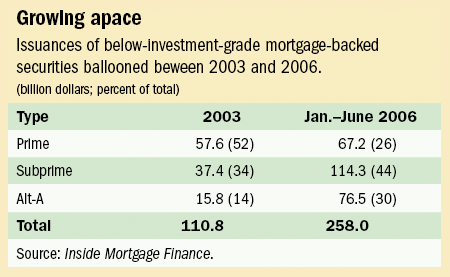~snip~
Private label securities
This market structure, with government-sponsored enterprises at its center, was a tremendous success and attracted competition from other major financial institutions. After the government charged Freddie Mac and Fannie Mae several years ago with serious errors in complying with new accounting rules for derivatives, the major Wall Street firms launched an aggressive move into the issuance of mortgage-backed securities.
In 2003, the government-sponsored enterprises were the source of 76 percent of the mortgage-backed and asset-backed issuances; "private label" issues by major Wall Street firms accounted for the remaining 24 percent, according to Inside Mortgage Finance. By mid-2006, the government-sponsored enterprise share had fallen to 43 percent, with private label issues accounting for 57 percent. Among the large private label issuers were well-known firms—such as Wells Fargo, Lehman Brothers, Bear Stearns, JPMorgan, Goldman Sachs, and Bank of America—as well as several major lenders to high-risk subprime borrowers, such as Indymac, WAMU, and Countrywide.
Along with this radical, and rapid, shift in market shares came a similar change in underwriting standards. Whereas Fannie Mae and Freddie Mac were almost entirely "prime" mortgage lenders, the private label share grew in large part through the origination and securitization of high-risk subprime mortgages as well as "Alt-A" mortgages, which were made to borrowers who were more creditworthy than subprime customers but presented more risks than prime borrowers (see table).
The rise of subprime mortgage origination and securitization created a problem that had not arisen in markets centered on government-sponsored enterprises. How can such low-rated debt securities be sold? The major buyers of prime mortgage-backed securities were institutional investors, but their investment rules and guidelines sharply restricted their exposure to below-investment-grade securities. Small amounts of the $1.1 trillion in subprime debt, $685 billion of which was securitized as mortgaged-backed securities, could be sold to various high-yield-seeking investors—but not nearly the entire amount.
Finding new investors
The key to moving subprime mortgage debt through the market was to divide up the risk, creating low-risk investment-grade segments and higher-risk (lower-rated) segments from the pool of mortgages. To do this, Wall Street used the collateralized debt obligation, which was created in 1987 by the now defunct investment firm Drexel Burnham Lambert as part of its junk-bond financing of leveraged buyouts.
The subprime mortgages were pooled into collateralized debt obligations, in which the securitized claims on the pool's payments were carved into various "tranches," or classes of risk. Like the underlying mortgages, the collateralized debt obligations paid principal and interest. In a simple three-tranche example, the least risky, or senior, tranche has the first claim on the payments from the pooled mortgages. The senior tranche has the highest credit rating, sometimes as high as AAA, and receives a lower interest rate. After the senior claims are paid, the middle, or mezzanine, tranche receives its payments. Mezzanine represents much greater risk and usually receives below-investment-grade credit ratings and a higher rate of return. The lowest, or equity, tranche receives payments only if the senior and mezzanine tranches are paid in full. The equity tranche suffers the first losses on the pool, is highly risky, and is usually unrated. It also offers the highest rate of return because of the risk. Each class of securities is sold separately and can be traded in secondary markets so that prices can be discovered for each level of risk.
In a collateralized debt obligation, approximately 80 percent of the subprime debt can be resold to institutional investors and others as senior-tranche, investment-grade assets. Hedge funds, the proprietary trading desks of Wall Street firms, and some institutional investors chasing high-yield investments found the lower tranches attractive.
FitchRatings warned in 2005, "Hedge funds have quickly become important sources of capital to the credit market," but "there are legitimate concerns that these funds may end up inadvertently exacerbating risks." That is because hedge funds, which invest in largely high-risk ventures, are not transparent entities—their assets, liabilities, and trading activities are not disclosed publicly—and they are sometimes highly leveraged, using derivatives or borrowing large amounts to invest. So other investors and regulators knew little of hedge funds' activities, while, as FitchRatings put it, because of their leverage, their "impact in the global credit markets is greater than their assets under management would indicate."
Press reports indicate that typical hedge fund leverage in the purchase of high-yield tranches was 500 percent. That means that $100 million in capital would be added to $500 million in borrowed funds for a $600 million investment in equity or mezzanine tranches of a subprime collateralized debt obligation. If these subordinate tranches were 20 percent of the total debt obligation, and the other 80 percent was sold as investment-grade senior debt to institutional investors, then that $100 million in hedge fund capital allowed originators and private label mortgage-backed securities issuers to move $3 billion through the subprime mortgage market—$2.4 billion as investment-grade securities and $600 million as high-yield junk.
~snip~
You'll note I was off on the market entrance dates for both the public and private entities. Still in all and as near as I can tell, the rest of the story remains the same.
